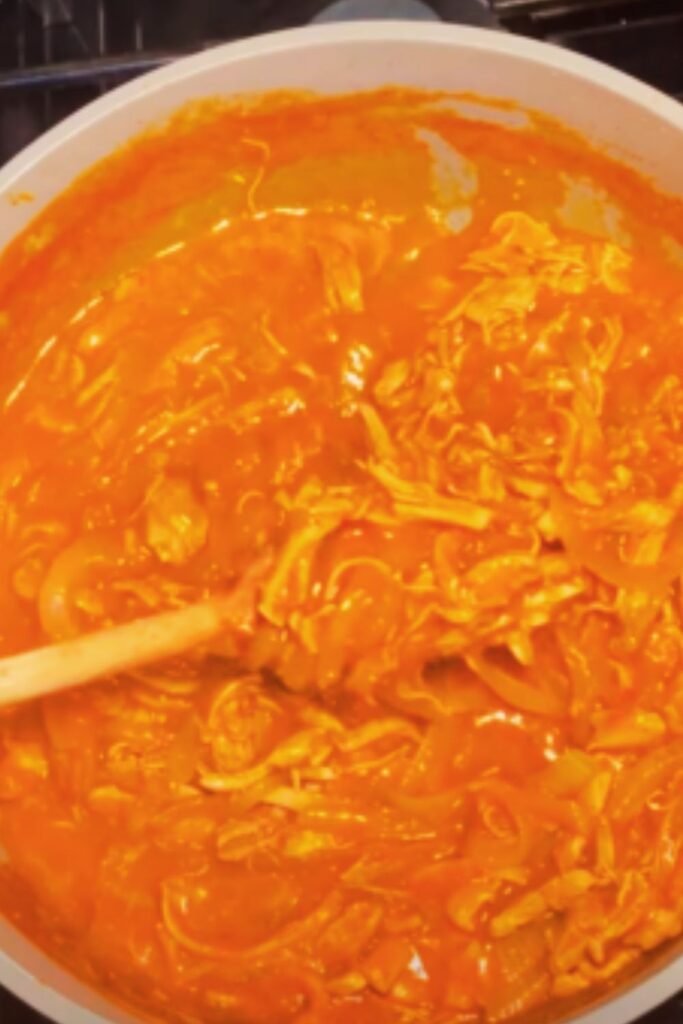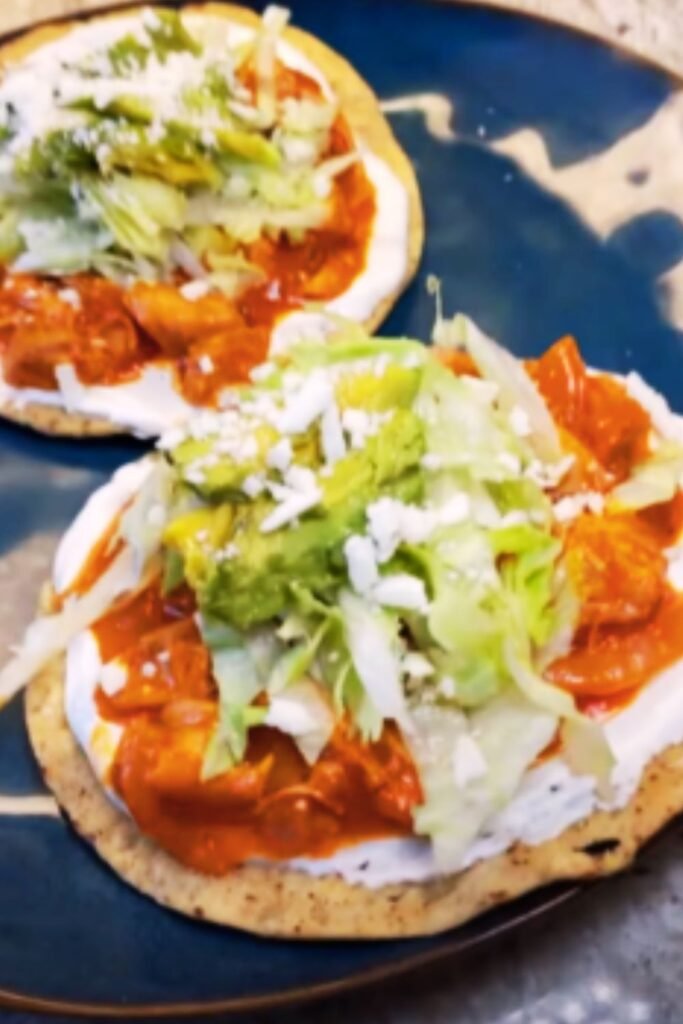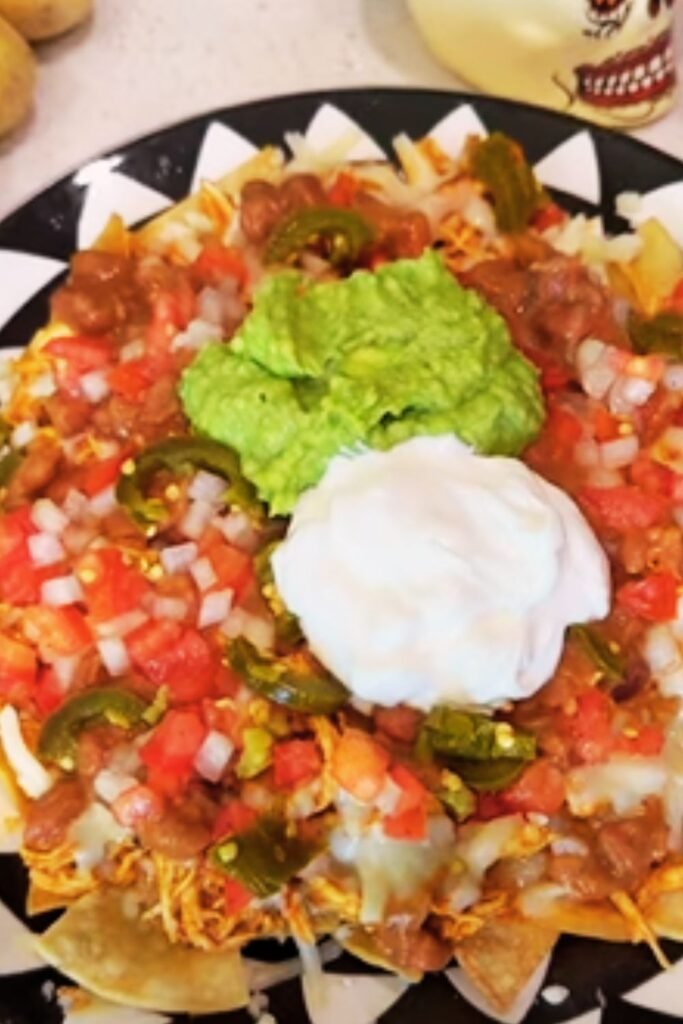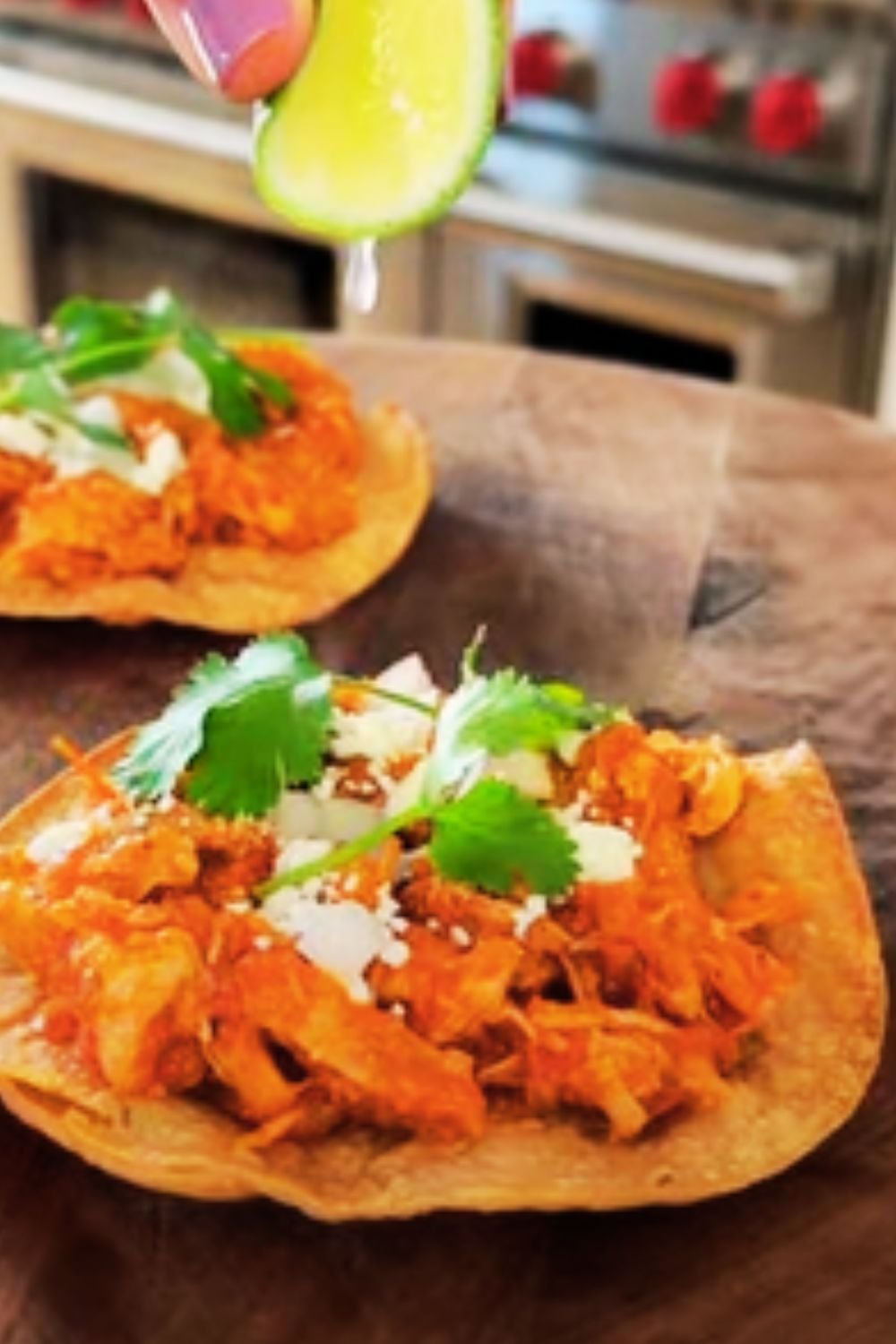When I first tasted authentic Tinga de Pollo in a small taqueria in Puebla, Mexico, I knew I had discovered something extraordinary. The tender, smoky shredded chicken swimming in a rich, chipotle-laden sauce was unlike anything I’d experienced before. That moment sparked my obsession with perfecting this traditional Mexican dish, and today I’m thrilled to share everything I’ve learned about creating this culinary masterpiece in your own kitchen.
Tinga de Pollo represents the heart and soul of Mexican comfort food. This beloved dish transforms humble chicken into something magical through the alchemy of smoky chipotle peppers, aromatic onions, and perfectly balanced seasonings. What makes this recipe truly special isn’t just its incredible flavor – it’s also remarkably versatile, serving as the foundation for countless Mexican meals from tacos to tostadas, quesadillas to enchiladas.
Understanding Tinga de Pollo: More Than Just Shredded Chicken
Tinga : A traditional Mexican cooking method that involves slow-cooking meat in a sauce made primarily with tomatoes, onions, and chipotle peppers in adobo sauce
Chipotle en Adobo : Smoked jalapeño peppers preserved in a tangy, slightly sweet sauce made from ground chiles, vinegar, garlic, and spices
Adobo Sauce : The dark red sauce that chipotle peppers are packed in, providing deep flavor complexity with smoky, sweet, and tangy notes
Poaching : A gentle cooking method using simmering liquid to cook chicken while keeping it moist and tender
The beauty of Tinga de Pollo lies in its simplicity and depth of flavor. Unlike many complex Mexican dishes that require dozens of ingredients, tinga achieves its remarkable taste through the careful balance of just a few key components. The dish originated in Puebla, Mexico, where home cooks developed this technique as a way to transform leftover or tough cuts of meat into something extraordinary.
Essential Ingredients for Authentic Tinga de Pollo
Creating exceptional Tinga de Pollo starts with selecting the right ingredients. I’ve experimented with countless variations over the years, and these components consistently deliver the most authentic results.
| Ingredient | Quantity | Purpose | Substitution Options |
|---|---|---|---|
| Chicken Thighs (bone-in, skin-on) | 2 lbs | Primary protein, provides rich flavor | Chicken breast (less flavorful), whole chicken pieces |
| Roma Tomatoes | 4 large | Base for sauce, adds natural sweetness | Canned whole tomatoes (drained), regular tomatoes |
| White Onion | 1 large | Aromatic foundation | Yellow onion, sweet onion |
| Chipotle Peppers in Adobo | 2-4 peppers | Smoky heat and signature flavor | Smoked paprika + cayenne (emergency substitute) |
| Adobo Sauce | 2-3 tablespoons | Depth of flavor, sweetness | Extra chipotle peppers, blended |
| Garlic | 4 cloves | Aromatic complexity | Garlic powder (1 teaspoon) |
| Bay Leaves | 2 leaves | Subtle herbal note | Mexican oregano |
| Salt | To taste | Flavor enhancement | Kosher salt, sea salt |
| Black Pepper | 1/2 teaspoon | Mild spice | White pepper |
| Chicken Broth | 2 cups | Poaching liquid | Water with bouillon, vegetable broth |

The Art of Preparing Perfect Tinga de Pollo
My approach to Tinga de Pollo has evolved significantly since those early attempts in my kitchen. Through trial and error, I’ve discovered that the secret to exceptional tinga lies not in exotic ingredients, but in proper technique and timing.
Step 1: Poaching the Chicken to Perfection
The foundation of exceptional tinga begins with properly cooked chicken. I always use bone-in, skin-on chicken thighs because they remain incredibly moist and flavorful throughout the cooking process. Here’s my proven method:
• Place chicken thighs in a large pot and cover completely with cold water • Add one quartered onion, two garlic cloves, bay leaves, and a generous pinch of salt • Bring to a gentle boil, then immediately reduce heat to maintain a very gentle simmer • Cook for 25-30 minutes until chicken reaches internal temperature of 165°F • Remove chicken and reserve the flavorful poaching liquid for later use • Allow chicken to cool completely before shredding by hand into bite-sized pieces
The key here is patience. Rushing this process by using high heat will result in tough, stringy chicken that lacks the tender texture that makes tinga so appealing.
Step 2: Creating the Smoky Tinga Sauce
While the chicken cools, I prepare the signature sauce that transforms simple shredded chicken into authentic tinga. This sauce is where the magic truly happens.
• Char the roma tomatoes directly over an open flame or under the broiler until skin blisters and blackens slightly • Let tomatoes cool, then remove most of the charred skin (leaving some for smoky flavor) • Blend charred tomatoes with chipotle peppers, adobo sauce, and garlic until smooth • Strain the mixture through a fine-mesh sieve for silky texture (optional but recommended)
The charring step might seem unnecessary, but it adds a subtle smokiness that complements the chipotle peppers beautifully. This technique is used throughout Mexican cuisine and makes a remarkable difference in the final flavor profile.
Step 3: Building Layers of Flavor
With both chicken and sauce prepared, the final cooking stage brings everything together:
• Heat oil in a large skillet over medium heat • Sauté sliced onions until translucent and slightly caramelized (about 8-10 minutes) • Add the tomato-chipotle sauce and cook for 5 minutes, stirring frequently • Incorporate shredded chicken and mix thoroughly to coat every piece • Add reserved poaching liquid gradually until desired consistency is reached • Season with salt and pepper to taste • Simmer gently for 15-20 minutes, allowing flavors to meld completely
Nutritional Profile and Health Benefits
Understanding the nutritional value of Tinga de Pollo helps appreciate why this dish has sustained Mexican families for generations. When prepared with my recipe, each serving provides substantial nutrition while remaining relatively healthy.
| Nutrient | Per Serving (4 oz) | Daily Value % | Health Benefits |
|---|---|---|---|
| Calories | 285 | 14% | Moderate calorie content |
| Protein | 32g | 64% | Muscle building and repair |
| Fat | 12g | 18% | Essential fatty acids |
| Saturated Fat | 3g | 15% | Energy source |
| Carbohydrates | 8g | 3% | Quick energy |
| Fiber | 2g | 8% | Digestive health |
| Sodium | 420mg | 18% | Electrolyte balance |
| Iron | 2.1mg | 12% | Oxygen transport |
| Vitamin C | 15mg | 17% | Immune support |
| Vitamin A | 850 IU | 17% | Eye health |
The chipotle peppers contribute significant amounts of capsaicin, which research suggests may boost metabolism and provide anti-inflammatory benefits. The tomatoes offer lycopene, a powerful antioxidant that becomes more bioavailable when cooked.
Serving Suggestions and Presentation Ideas
Tinga de Pollo’s versatility makes it one of my favorite dishes to prepare for both casual weeknight dinners and entertaining guests. The smoky, rich flavors complement numerous accompaniments and presentations.
Traditional Mexican Presentations
• Tacos de Tinga: Warm corn tortillas filled with tinga, topped with diced onion, cilantro, and lime • Tostadas: Crispy tortillas topped with refried beans, tinga, lettuce, Mexican crema, and queso fresco • Quesadillas: Large flour tortillas filled with tinga and melted cheese, griddled until golden • Sopes: Thick corn tortilla boats topped with beans, tinga, and traditional garnishes
Modern Fusion Applications
• Tinga Rice Bowls: Served over cilantro-lime rice with black beans, avocado, and pickled jalapeños • Stuffed Sweet Potatoes: Baked sweet potatoes topped with tinga and fresh garnishes • Tinga Salad: Mixed greens topped with warm tinga, pepitas, and lime vinaigrette • Breakfast Hash: Tinga served with fried eggs and breakfast potatoes

Storage, Reheating, and Meal Prep Strategies
One of the aspects I love most about Tinga de Pollo is how well it stores and reheats, making it perfect for meal prep and batch cooking.
| Storage Method | Duration | Best Practices | Reheating Instructions |
|---|---|---|---|
| Refrigerator | 4-5 days | Store in airtight container, separate from garnishes | Gentle stovetop heating with splash of broth |
| Freezer | 3 months | Freeze in portion-sized containers, leave headspace | Thaw overnight, reheat slowly on stovetop |
| Vacuum Sealed | 6 months | Remove air completely, label with date | Thaw in refrigerator, reheat gently |
For meal prep success, I recommend preparing a large batch on Sunday and portioning it into individual containers. The flavors actually improve after a day or two in the refrigerator, as the spices have more time to meld together.
Troubleshooting Common Tinga Challenges
Throughout my years of making tinga, I’ve encountered and solved numerous issues that home cooks commonly face. Here are the most frequent problems and my proven solutions:
Problem: Dry, Stringy Chicken Solution: Always use dark meat (thighs), poach gently, and don’t overcook. If chicken becomes dry, add more reserved poaching liquid during the final simmering stage.
Problem: Sauce Too Spicy Solution: Add more tomatoes to the sauce blend, or incorporate a small amount of sugar or honey to balance the heat. Remember, you can always add more chipotle, but you can’t take it away.
Problem: Sauce Too Thin Solution: Simmer uncovered longer to reduce liquid, or blend in an additional tomato. Some cooks add a small amount of tomato paste for thickness.
Problem: Lack of Smoky Flavor Solution: Ensure you’re using actual chipotle peppers in adobo sauce, not just regular jalapeños. Charring the tomatoes also adds essential smokiness.
Regional Variations and Cultural Context
Tinga de Pollo varies significantly across different regions of Mexico, each area adding its own cultural touch to this beloved dish. In Puebla, where the dish originated, cooks often add Mexican chorizo for extra richness. Oaxacan versions frequently include a touch of mezcal, while coastal regions might incorporate a hint of lime juice.
Understanding these variations has deepened my appreciation for tinga’s cultural significance. This isn’t just a recipe – it’s a reflection of Mexican ingenuity in creating delicious, satisfying meals from simple, accessible ingredients.
Advanced Techniques for Flavor Enhancement
After mastering the basic technique, I’ve discovered several advanced methods that elevate tinga from good to extraordinary:
Toasting Whole Spices: Lightly toast cumin seeds and Mexican oregano in a dry pan before grinding and adding to the sauce. This releases essential oils and intensifies flavors dramatically.
Slow Cooker Adaptation: After building the base sauce, everything can be transferred to a slow cooker for 4-6 hours on low heat. This method produces incredibly tender chicken and deeply developed flavors.
Pressure Cooker Method: Using an Instant Pot or pressure cooker reduces cooking time to 45 minutes while maintaining traditional flavors and textures.

Pairing Suggestions and Complete Meal Planning
Creating a complete Mexican meal around Tinga de Pollo involves thoughtful consideration of complementary flavors and textures. I’ve found these combinations work exceptionally well:
Refreshing Beverages
• Fresh agua frescas (horchata, jamaica, tamarindo) • Mexican sodas like Jarritos or Coca-Cola made with cane sugar • Fresh lime agua with a pinch of salt • Iced hibiscus tea with lime and mint
Side Dishes That Shine
• Mexican rice with cilantro and lime • Refried beans topped with queso fresco • Elote (Mexican street corn) salad • Pickled jalapeños and carrots (escabeche) • Fresh guacamole with warm tortilla chips
Questions and Answers About Tinga de Pollo
Q: Can I make Tinga de Pollo without chipotle peppers?
While chipotle peppers are essential for authentic tinga flavor, you can create a milder version using smoked paprika combined with a small amount of cayenne pepper. However, the distinctive smoky-sweet flavor won’t be quite the same.
Q: How spicy is traditional Tinga de Pollo?
Traditional tinga has moderate heat – warm and flavorful without being overwhelming. The chipotle peppers provide more smokiness than intense heat. Start with 2 peppers and adjust according to your preference.
Q: Can I use chicken breast instead of thighs?
You can use chicken breast, but the result will be less flavorful and potentially drier. If using breast meat, reduce cooking time and be extra careful not to overcook. Adding a bit more poaching liquid helps maintain moisture.
Q: What’s the difference between chipotle peppers and regular jalapeños?
Chipotle peppers are jalapeños that have been smoked and dried. This process concentrates their flavor and adds the distinctive smokiness that’s essential to authentic tinga. Fresh jalapeños won’t provide the same depth of flavor.
Q: How far in advance can I prepare Tinga de Pollo?
Tinga actually improves when made a day ahead, allowing flavors to meld beautifully. You can prepare it up to 3 days in advance and store it refrigerated. The flavors continue developing, making it even more delicious.
Q: Is Tinga de Pollo gluten-free?
Yes, traditional Tinga de Pollo is naturally gluten-free when served with corn tortillas. However, always check labels on canned chipotle peppers and any additional seasonings to ensure they don’t contain gluten-containing additives.
Q: Can I freeze leftover tinga?
Absolutely! Tinga freezes beautifully for up to 3 months. Freeze in portion-sized containers, leaving some headspace for expansion. Thaw overnight in the refrigerator and reheat gently on the stovetop with a splash of broth if needed.
Q: What’s the best way to shred the chicken?
I prefer shredding by hand once the chicken has cooled slightly. This gives you better control over the size and texture of the pieces. Two forks work well too, but avoid using a food processor as it can make the chicken too fine.
Q: Can I make this dish vegetarian?
While traditional tinga uses chicken, you can create a delicious vegetarian version using jackfruit, mushrooms, or even cauliflower. The key is maintaining the smoky chipotle sauce that gives tinga its characteristic flavor.
Q: Why do you char the tomatoes?
Charring tomatoes adds a subtle smoky flavor that complements the chipotle peppers perfectly. This technique is common in Mexican cuisine and adds depth that you simply can’t achieve with raw or simply cooked tomatoes.
Creating perfect Tinga de Pollo has become one of my greatest culinary joys. This dish represents everything I love about Mexican cuisine – bold flavors, simple techniques, and incredible versatility. Whether you’re preparing a quick weeknight dinner or hosting a festive gathering, tinga delivers satisfaction and authenticity that never fails to impress.
The journey from that first taste in Puebla to mastering this recipe in my own kitchen has taught me that the best Mexican food doesn’t require complicated techniques or exotic ingredients. Instead, it demands respect for tradition, quality ingredients, and patience to let flavors develop naturally. Every time I prepare tinga, I’m reminded of the generous Mexican cooks who shared their knowledge and passion for this incredible dish.
Take your time with each step, taste frequently, and don’t be afraid to adjust seasonings to match your preferences. Most importantly, enjoy the process and the amazing aromas that will fill your kitchen as this Mexican masterpiece comes together.
